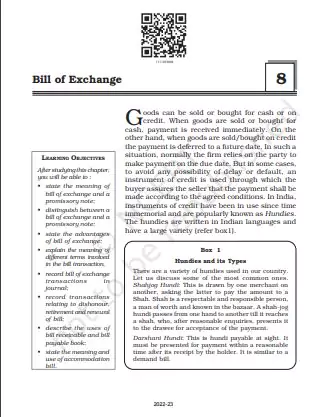‘NCERT Solutions for Class 11 Accountancy Chapter 8 Bills of Exchange‘ PDF Quick download link is given at the bottom of this article. You can see the PDF demo, size of the PDF, page numbers, and direct download Free PDF of ‘Ncert Class 11 Accountancy Chapter 8 Exercise Solution’ using the download button.
Bills of Exchange Textbook With Solution PDF Free Download

Chapter 8: Bills of Exchange
G oods can be sold or bought for cash or on credit. When goods are sold or bought for cash, payment is received immediately.
On the other hand, when goods are sold/bought on credit the payment is deferred to a future date. In such a situation, normally the firm relies on the party to make payment on the due date.
But in some cases, to avoid any possibility of delay or default, an instrument of credit is used through which the buyer assures the seller that the payment shall be made according to the agreed conditions.
In India, instruments of credit have been in use since time immemorial and are popularly known as Hundies.
The hundies are written in Indian languages and have a large variety Now a days these instruments of credit are called bills of exchange or promissory notes.
The bill of exchange contains an unconditional order to pay a certain amount on an agreed date while the promissory note contains an unconditional promise to pay a certain sum of money on a certain date.
In India these instruments are governed by the Indian Negotiable Instruments Act 1881.
Meaning of Bill of Exchange According to the Negotiable Instruments Act 1881, a bill of exchange is defined as an instrument in writing containing an unconditional order, signed by the maker, directing a certain person to pay a certain sum of money only to, or to the order of a certain person or to the bearer of the instrument.
The following features of a bill of exchange emerge out of this definition. • A bill of exchange must be in writing. • It is an order to make payment. • The order to make payment is unconditional. • The maker of the bill of exchange must sign it.
The payment to be made must be certain. • The date on which payment is made must also be certain. • The bill of exchange must be payable to a certain person.
The amount mentioned in the bill of exchange is payable either on demand or on the expiry of a fixed period of time. • It must be stamped as per the requirement of law. A bill of exchange is generally drawn by the creditor upon his debtor.
It has to be accepted by the drawee (debtor) or someone on his behalf. It is just a draft till its acceptance is made.
For example, Amit sold goods to Rohit on credit for ` 10,000 for three months. To ensure payment on due date Amit draws a bill of exchange upon Rohit for ` 10,000 payable after three months.
Before it is accepted by Rohit it will be called a draft. It will become a bill of exchange only when Rohit writes the word “accepted” on it and append his signature thereto communicate his acceptance.
Parties to a Bill of Exchange There are three parties to a bill of exchange: (1) Drawer is the maker of the bill of exchange.
A seller/creditor who is entitled to receive money from the debtor can draw a bill of exchange upon the buyer/debtor.
The drawer after writing the bill of exchange has to sign it as maker of the bill of exchange. (2) Drawee is the person upon whom the bill of exchange is drawn.
Drawee is the purchaser or debtor of the goods upon whom the bill of exchange is drawn. (3) Payee is the person to whom the payment is to be made.
The drawer of the bill himself will be the payee if he keeps the bill with him till the date of its payment.
The payee may change in the following situations: (a) In case the drawer has got the bill discounted, the person who has discounted the bill will become the payee; (b) In case the bill is endorsed in favour of a creditor of the drawer, the creditor will become the payee.
Normally, the drawer and the payee is the same person. Similarly, the drawee and the acceptor is normally the person.
For example, Mamta sold goods worth `10,000 to Jyoti and drew a bill of exchange upon her for the same amount payable after three months.
Here, Mamta is the drawer of the bill and Jyoti is the drawee. If the bill is retained by Mamta for three months and the amount of ` 10,000 is received by her on the due date then Mamta will be the payee.
If Mamtagives away this bill to her creditor Ruchi, then Ruchi will be the payee. If Mamta gets this bill discounted from the bank then the bankers will become the payee.
| Author | NCERT |
| Language | English |
| No. of Pages | 42 |
| PDF Size | 2.8 MB |
| Category | Accountancy |
| Source/Credits | ncert.nic.in |
NCERT Solutions Class 11 Accountancy Chapter 8 Bills of Exchange
1. Name any two types of commonly used negotiable instruments.
1. Promissory Notes
2. Cheques
2. Write two points of distinction between bills of exchange and promissory note.
| Basis of Distinction | Bills of Exchange | Promissory Note |
| Drawn by | Creditor | Debtor |
| Parties Involved | Three parties are involved which are drawer, payee and drawee. | It involves two parties which are payee and drawer/maker. |
3. State any four essential features of bill of exchange.
The following four features are considered essential for a bill of exchange:
1. The bill of exchange must be in writing
2. A bill of exchange should contain an unconditional order to pay.
3. Drawer of the bill must sign the bill.
4. The amount and the expiry date should be mentioned specifically in the bill of exchange.
4. State the three parties involved in a bill of exchange.
A bill of exchange involves three parties and they are:
1. Drawer/Maker/Holder- Responsible for issuing the bill
2. Payee/Holder- The person who will receive the payment
3. Drawee/Acceptor- One who has to accept the bill
NCERT Class 11 Accountancy Textbook Chapter 8 Bills of Exchange With Answer PDF Free Download
